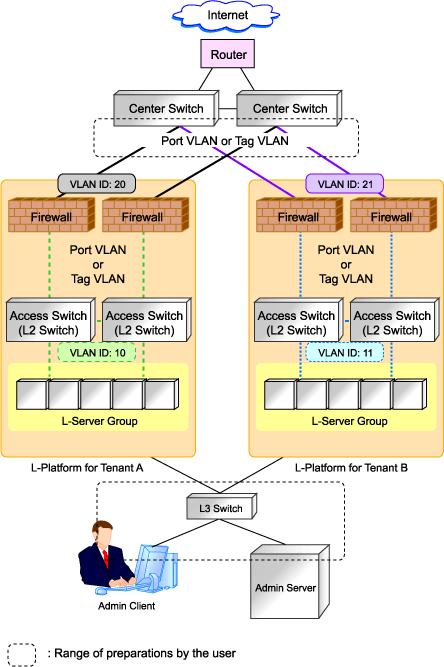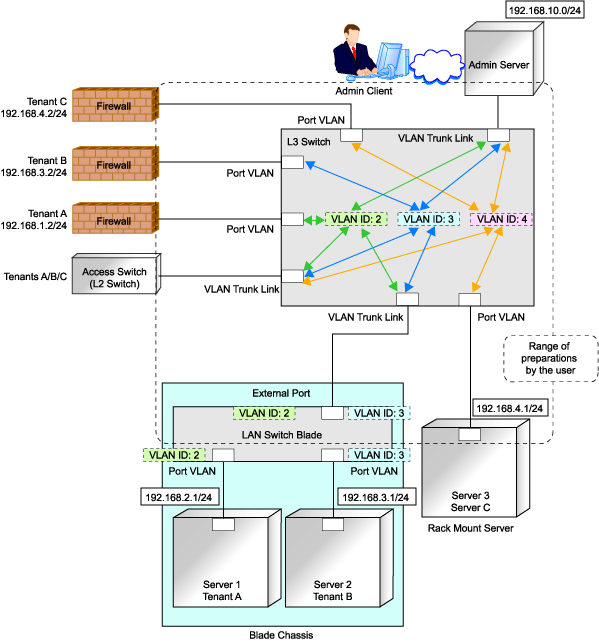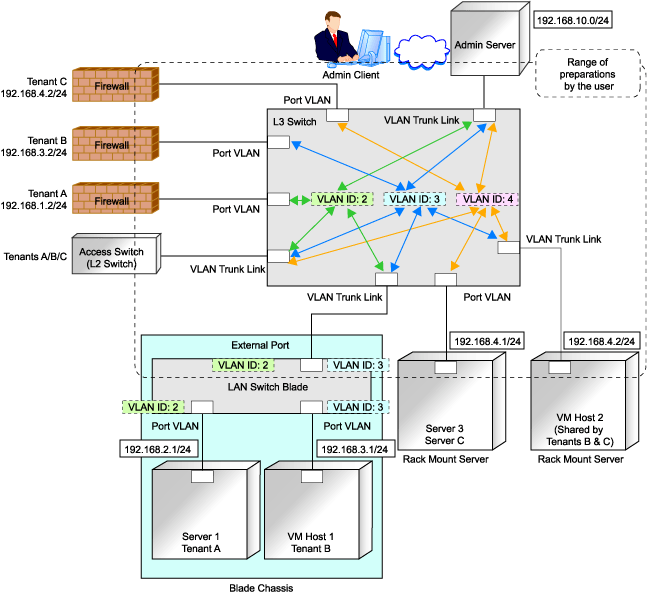Define the configuration settings necessary for management of the defined network environment.
Information
In addition to the information necessary for management by Resource Orchestrator, additional information is required to operate each device.
For example, the following configuration information is necessary:
Configuration information necessary for saving and referring to the logs output by individual devices
Configuration information necessary for backing up and restoring the information from individual devices
Refer to the manuals of the devices to be used to check the information necessary for operation.
Define the following information to be configured on the admin server.
Device name
IP address used by the admin server for management purposes
Decide the IP address for the network interface used to communicate with managed servers and network devices.
Define the following information to be configured on the admin clients.
Device name
Routing information
When the admin IP address of the admin client is in a different subnet from that of the admin server, check the network device that works as the gateway, and define the routing information accordingly.
Define the following information to be configured on each of the network devices.
Settings for Management
Define configuration information necessary for management.
Device name
Define the name of the managed device.
This name can contain up to 32 alphanumeric characters (upper or lower case), underscores ("_"), hyphens ("-"), and periods (".").
IP addresses used by managed network devices for management purposes
Choose an IP address to be used for communication with the admin server.
SNMP community name
Define the name of the SNMP community to be used when collecting MIB information using the monitoring function of the network device.
This user name can contain up to 32 alphanumeric characters (upper or lower case), underscores ("_"), and hyphens ("-").
Administrator information (user name and password)
Telnet Login User Name
Define the Telnet login user name to be used for logging into the network device.
This user name can contain up to 32 alphanumeric characters (upper or lower case), underscores ("_"), and hyphens ("-").
Telnet Password
Define the password for the Telnet login user name to be used for directly logging into the network device.
This user name can contain up to 32 alphanumeric characters (upper or lower case), underscores ("_"), and hyphens ("-").
Administrator Password
Define the login password for the administrator to be used for logging into the network device as an administrator.
This user name can contain up to 32 alphanumeric characters (upper or lower case), underscores ("_"), and hyphens ("-").
SNMP trap destination
This must be the admin IP address of the admin server.
Monitoring method (PING, SNMP)
Define the monitoring methods for the network devices (firewalls, L2 switches, and L3 switches).
Choose PING for monitoring active/inactive status, and choose SNMP for status monitoring.
It is possible to monitor using only one method or both methods.
Settings for Pre-configuration
Define settings necessary for pre-configuration.
Public LAN Pre-configuration Settings
Check the connection configuration of the LAN ports to be used for the public LAN to be connected with the center switches, and define the necessary settings accordingly.
Admin LAN Pre-configuration Settings
Check the connection configuration of the LAN ports to be used for the admin LAN to be connected with the L3 switches, and define the necessary settings accordingly.
Figure 4.11 Managed Device Pre-configuration Scope

Information
Character limitations vary depending on the network device used.
For specific settings of individual devices, define the settings according to the specifications of the network devices, within the limitations of types and number of characters described above.
The information necessary to be configured based on the public and admin LAN connection configurations also depends on the specifications of network devices.
For details on the specifications for each network device, refer to the manual for each device.
Define the information to be configured on each unmanaged network device.
Figure 4.12 Example of the Configuration Scope of Unmanaged Network Devices

Public LAN Pre-configuration Settings
Define the public LAN settings that must be pre-configured by users.
Routing Information
Define the routing method for the routers and center switches to enable communication with the L-Platform network.
VLAN Information
Check the VLAN information of routers and center switches used within the L-Platform network, and then define the VLAN information necessary for connection and communication with L-Platforms.
Redundancy Information
Check whether to make network devices and communication routes redundant, and then define any settings necessary for redundant configuration.
Admin LAN Settings
Define the admin LAN settings that must be pre-configured by users.
Figure 4.13 Admin LAN Network Configuration

Figure 4.14 Admin LAN Network Configuration (with Both Servers and VM Hosts)

Routing information
When the admin server and individual devices (servers, storage units, network devices, and admin clients) belong to different subnets, define the routing method on the L3 switch to enable communication between the admin server and individual devices using the admin LAN.
When using routing protocols (such as RIP and OSFP), define the information necessary for configuring dynamic routing. When not using dynamic routing, define the settings for the routing information table.
In addition, it is necessary to configure the following multicast routing for managed resources from the admin server.
225.1.0.1 - 225.1.0.8 |
VLAN information
Check the VLAN information of external ports of LAN switch blades and L3 switches used in the admin LAN network, and define the settings (VLAN IDs). Set the ports to be used as trunk links when necessary.
Redundancy information
Check whether to make network devices and communication routes redundant, and then define any settings necessary for redundant configuration.
Access control information
When configuring access control on L3 switches, define the ports that allow connection, because it is necessary to allow connection with the ports used by Resource Orchestrator.
Refer to "Appendix A Port List", for details on the ports used by Resource Orchestrator.
Define whether to allow or block communication when the routing is operating in order to define the access control.
When using the following functions, it is necessary to configure DHCP relay agents to enable the manager to receive DHCP requests from managed servers belonging to different subnets.
Backup and restoration of managed servers
Collection and deployment of cloning images
SAN boot using HBA address rename
When using the HBA address rename setup service, it is necessary to configure DHCP relay agents to enable the HBA address rename setup service to receive DHCP requests from managed servers belonging to different subnets.
Define the following information to be configured on the servers to be managed.
Device name
IP addresses used by managed servers for management purposes
Choose an IP address to be used for communication with the admin server.
IP Address of iSCSI Initiator
Choose an IP address for the network interface to use for communication with managed servers.
This is not necessary for servers for which iSCSI is not enabled.
Note
IP addresses chosen for iSCSI should be static and do not used DHCP.
When using a multi-path configuration using iSCSI, separate the networks using different ports.
Interface segments and virtual switches also need to be separated.
Ensure that all of the IP addresses configured here are on the same subnet.
For blade servers, also define the following information to be configured on LAN switch blades.
VLAN IDs for the admin LAN ports used to communicate with the admin server
IP addresses used by managed network devices for management purposes
Choose an IP address to be used for communication with the admin server.
SNMP community name
Define the name of the SNMP community to be used when collecting MIB information from the LAN switch blade.
This user name can contain up to 32 alphanumeric characters (upper or lower case), underscores ("_"), and hyphens ("-").
Administrator information (user name and password)
Telnet Login User Name
Define the Telnet login user name to be used for directly logging into the LAN switch blade.
This user name can contain up to 64 alphanumeric characters (upper or lower case), underscores ("_"), and hyphens ("-").
Telnet Password
Define the password of the Telnet login user name to be used for directly logging into the LAN switch blade.
This password can contain up to 80 alphanumeric characters (upper or lower case) and symbols (ASCII characters 0x20, 0x21, and 0x23 to 0x7e) with the exception of double quotation marks ( " ).
Administrator Password
Define the login password for the administrator to be used for directly logging into the LAN switch blade as an administrator.
This password can contain up to 80 alphanumeric characters (upper or lower case) and symbols (ASCII characters 0x20, 0x21, and 0x23 to 0x7e) with the exception of double quotation marks ( " ).
SNMP trap destination
This must be the admin IP address of the admin server.
Define the following information to be configured on storage units.
Device name
IP address used by managed storage for management purposes
Choose an IP address to be used for communication with the admin server.
IP address of iSCSI target
Define the IP address of the storage unit with which the iSCSI initiator will communicate.
This is not necessary for storage units for which iSCSI is not enabled.
Note
IP addresses chosen for iSCSI should be static and do not used DHCP.
When using a multi-path configuration, separate the networks using different ports.
Ensure that all of the IP addresses configured here are on the same subnet.
Define the following information to be configured on each of the other hardware devices.
Other hardware devices include "server management units", "power monitoring devices", etc.
Device name
IP addresses used by other hardware devices for management purposes
Choose an IP address to be used for communication with the admin server.